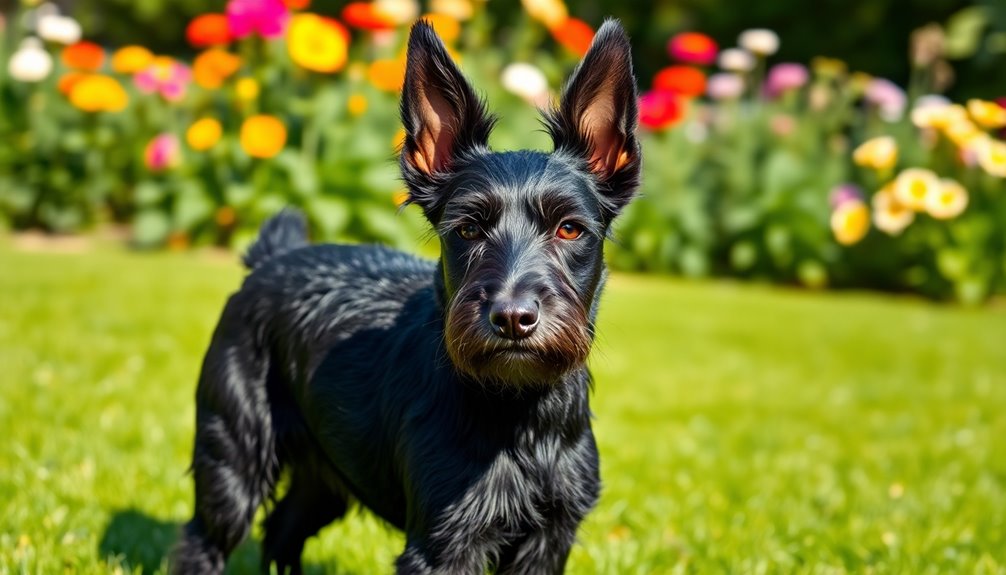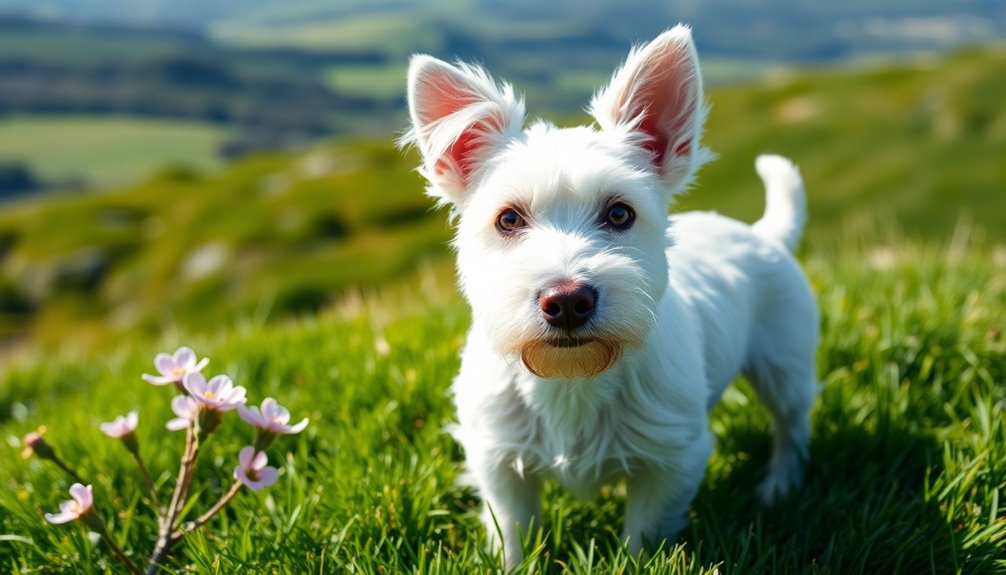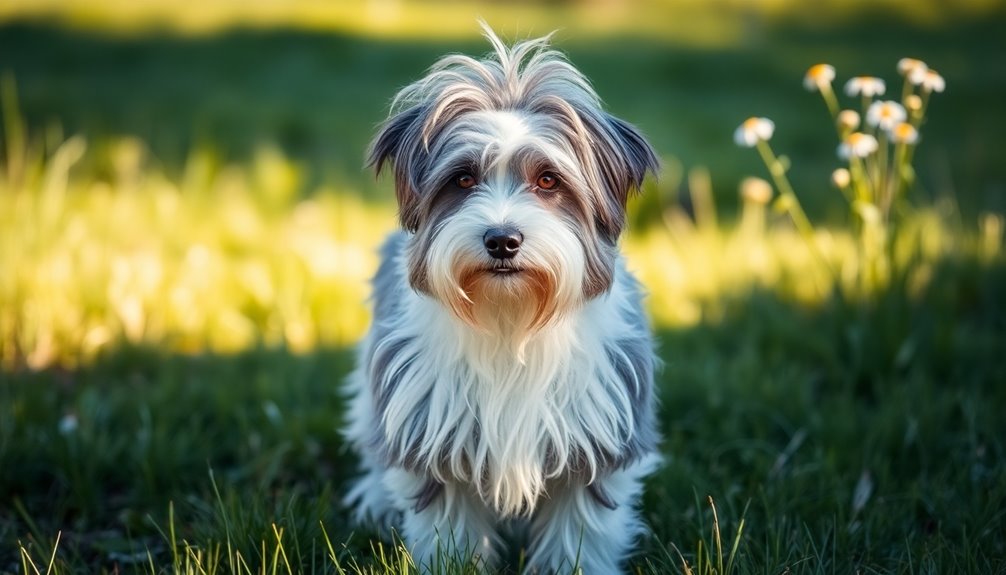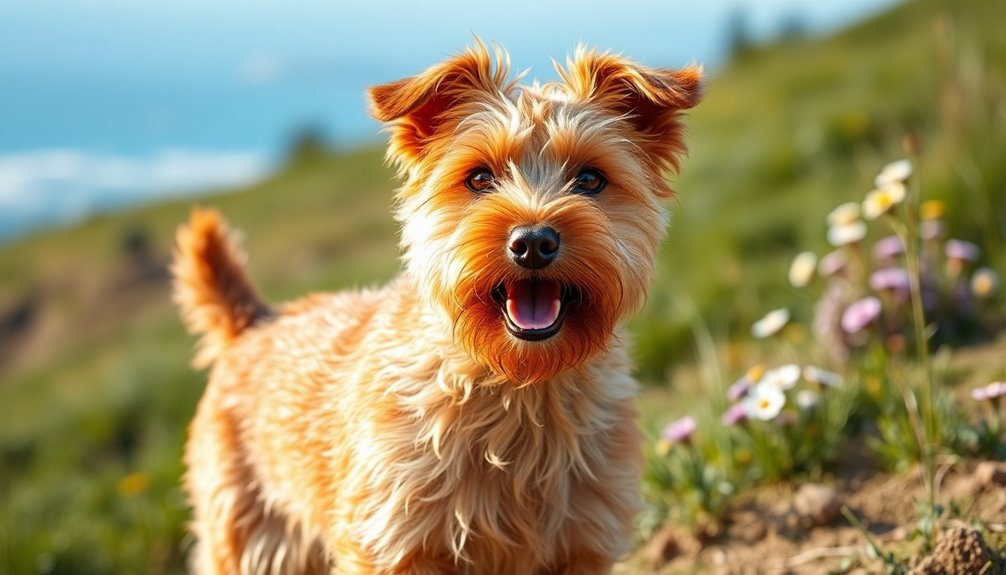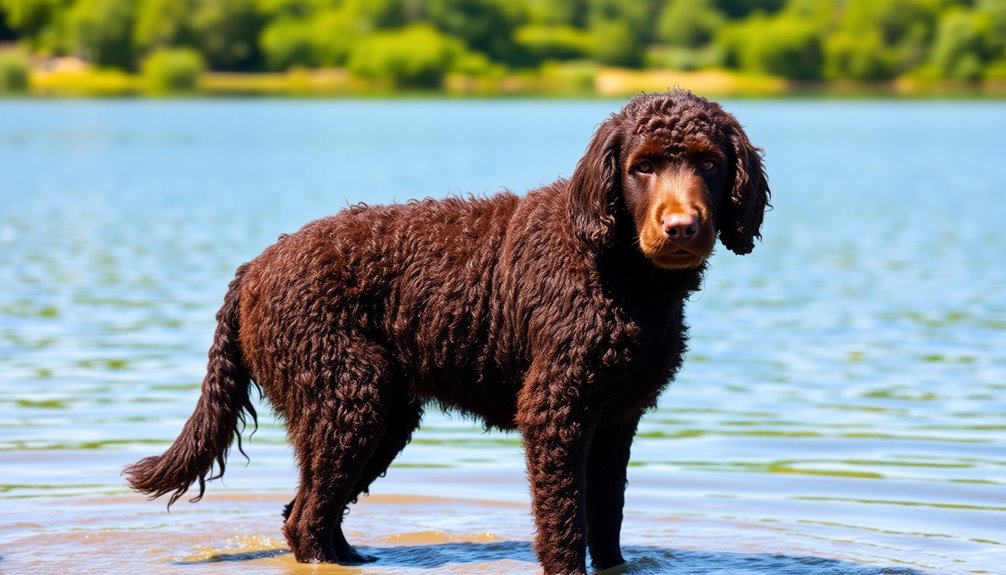The Scottish Terrier is your bold and independent companion, full of personality. Standing about 10 inches tall and weighing between 18-22 pounds, they boast a wiry double coat in various colors. Their spirited nature makes them loyal and alert, but can also lead to stubbornness at times. Regular grooming helps maintain their coat, while daily exercise keeps them physically and mentally stimulated. They thrive with experienced handlers who can guide their independent streak. With the right care and training, these fascinating terriers offer endless charm and companionship. You might find out more intriguing details about them ahead.
Key Takeaways
- Scottish Terriers are known for their spirited and independent nature, making them bold companions for experienced handlers.
- They have a sturdy build, standing about 10 inches tall and weighing between 18-22 pounds, ideal for active lifestyles.
- Their wiry double coat requires daily grooming to prevent matting and maintain a healthy appearance.
- Regular exercise and mental stimulation are essential, needing about 30-45 minutes of activity daily to thrive.
- Early socialization is crucial for their compatibility with other pets, ensuring they develop good social skills.
Introduction
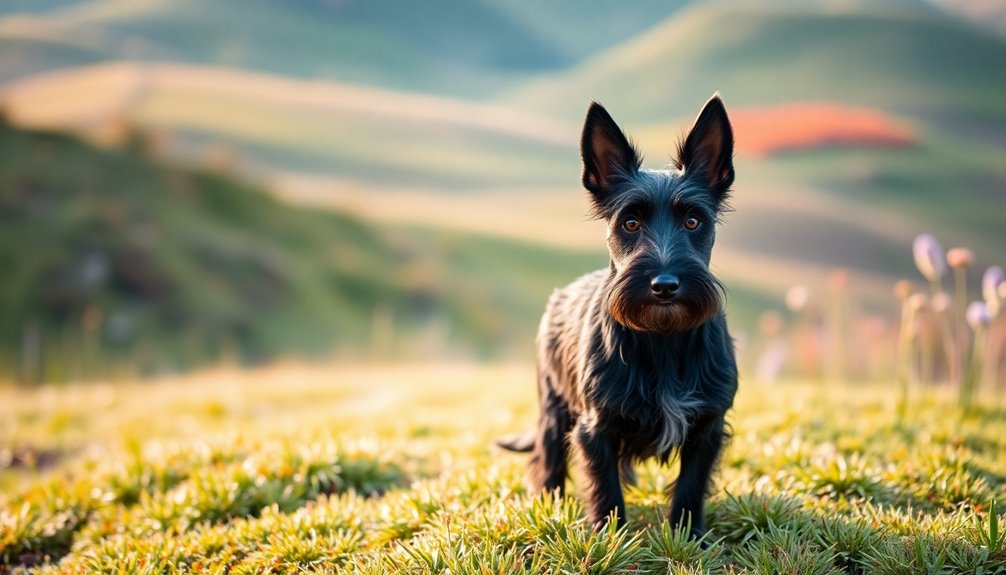
When you think of the Scottish Terrier, you might picture a small, sturdy dog with a striking appearance and a spirited personality. Standing around 10 inches tall and weighing between 18 to 22 pounds, this compact breed boasts a wiry double coat that comes in various colors, including black, brindle, and wheaten. Its short legs and solid build give it a confident stance, making it easily recognizable.
The Scottish Terrier's temperament is just as distinctive. You'll find them alert and spirited, always watchful of strangers or perceived threats. Although they're loyal and affectionate with their families, they aren't the type to curl up on your lap. Their independent nature can come off as stubbornness, but it's part of what makes them so unique. To maintain their health, they require routine veterinary care to monitor for hereditary issues that may affect them.
This breed requires moderate exercise, so daily walks are ideal, but don't expect them to keep up with you on a jog. Mental stimulation is crucial to keep them engaged and prevent boredom.
With proper care, including regular grooming and a balanced diet, Scottish Terriers can live a healthy life of 12 to 14 years.
History and Origin
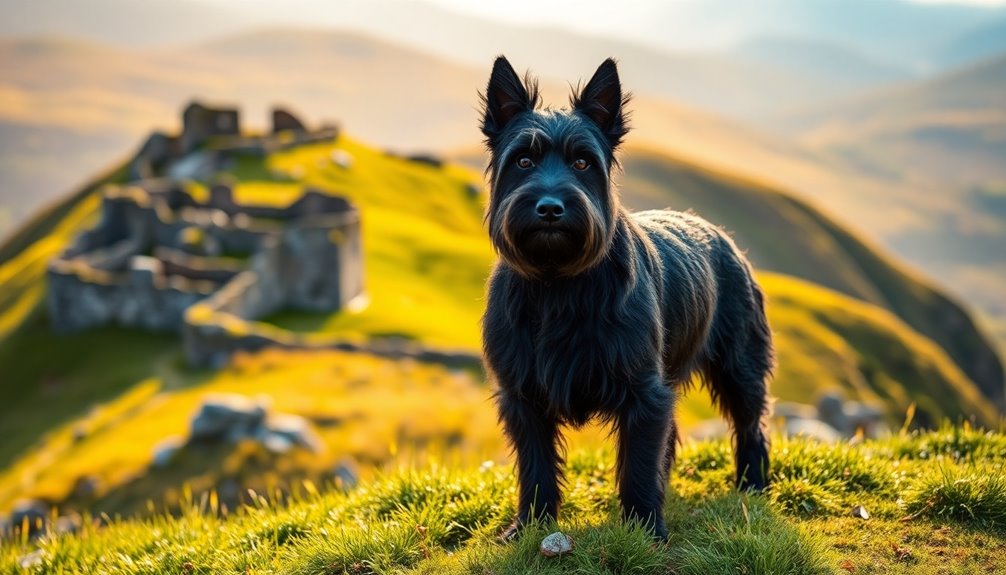
The Scottish Terrier has its roots in the rugged Highlands of Scotland, with early records dating back to 1436. Bred primarily for ratting and burrowing assistance, these tenacious dogs were invaluable on farms for controlling vermin. You'll discover how their brave nature and sturdy build made them essential companions for hunters in their native land. Their historical significance is highlighted by their recognition by the AKC in 1884, solidifying their place in the canine world.
Where and when the breed originated
Have you ever wondered where the Scottish Terrier originated? This bold breed hails from the rugged highlands of Scotland, particularly the Blackmount region of Perthshire and the Moor of Rannoch.
While the Isle of Skye is often associated with the breed, early records can be a bit murky. Farmers and gamekeepers primarily kept these dogs for vermin control, and they were bred in various highland communities.
The first written mention of these terriers dates back to 1436 by Don Leslie. Throughout the 16th century, similar terriers began appearing in records, hinting at the breed's early roots.
It wasn't until the late 19th century that efforts to distinguish and refine the Scottish Terrier gained momentum. Captain W. W. Mackie toured Scotland in the 1870s, documenting these dogs, and by 1879, they were first exhibited at Alexandra Palace in England. Notably, the breed's formal recognition was further solidified with the establishment of the Scottish Terrier Breeders and Exhibitors Association in 1934.
Initially grouped under the broad term "Skye Terriers," they were officially separated into distinct breeds later on. The breed standardization, crucial for their identity, was shaped by notable individuals like Captain Gordon Murray and S.E. Shirley, solidifying the Scottish Terrier's unique place in canine history.
Ratting and Burrowing Assistance
Scottish Terriers were originally bred for their remarkable abilities in ratting and burrowing, making them invaluable companions on farms and in the rugged landscapes of Scotland. Their primary role was to hunt vermin, clearing out pests from buildings and driving badgers from their dens. Their name is derived from the Latin word "terra," meaning earth, highlighting their talent for going underground.
These sturdy dogs possess a large head to accommodate their strong teeth and protect their deep-set eyes. Their short, stout legs and powerful feet allow them to dig effectively, while their well-sprung rib cage and muscular loin equip them for close quarters. You'll find that their muscular neck helps pull prey from dens, showcasing their physical prowess. Interestingly, Scottish Terriers were primarily from the West of Scotland, which is where they honed their skills in hunting and burrowing.
Behaviorally, Scottish Terriers are independent and rugged, driven by a natural hunting instinct. They're alert and inquisitive, capable of running the fields in various weather conditions.
While they may bark only when necessary, they're also fearless, sometimes aggressive with other dogs unless properly socialized. Over time, breed standards were established to emphasize these essential traits, solidifying their reputation as skilled hunters.
Physical Characteristics

When you look at a Scottish Terrier, you'll notice its compact size and sturdy build, standing about 25 cm tall and weighing between 8 to 10 kg.
Their hard, wiry coat comes in various colors, including black, brindle, and wheaten, and you can't miss those bushy eyebrows and beard that give them a distinctive expression.
These features not only enhance their charm but also require regular grooming to keep them looking their best.
Size, weight, and coat details
The Scottish Terrier is a compact, sturdy breed known for its distinctive physical characteristics. Standing about 10 inches tall, both males and females share a short-legged, low frame that gives them a robust appearance. Males typically weigh between 19 to 22 pounds, while females range from 18 to 21 pounds. On average, you can expect a male to weigh around 20 pounds and a female about 19 pounds, showcasing a well-balanced build with good muscle and bone density.
Their coat is another defining feature. The outer coat is hard, wiry, and weather-resistant, complemented by a soft, dense undercoat. You'll notice longer furnishings on their beard, legs, and lower body, which adds to their unique look. The coat should present a broken-haired texture that requires regular maintenance, including plucking and conditioning, to keep it in top shape. Regular vet check-ups are also recommended to ensure their overall health and coat condition.
As for color, Scottish Terriers come in various shades like black, brindle, gray, and wheaten. Each dog's coat may include patterns like brindle or markings such as a black mask, but no specific color is favored in breed standards.
Bushy Eyebrows and Beard
Bushy eyebrows and a prominent beard define the Scottish Terrier's facial charm, giving it a distinctive silhouette that's hard to miss. These iconic features not only enhance the breed's sharp and alert appearance but also contribute to its unique expression.
When you look at a Scottish Terrier, those bushy eyebrows and beard create an impression of boldness and confidence, making the dog appear dignified and intelligent. This breed's independent spirit adds to its bold demeanor, showcasing its fearless nature.
To maintain this striking look, regular grooming is essential. You'll want to trim the beard and eyebrows to follow the natural contours of the face. Using sharp, curved grooming scissors can help you achieve a neat appearance while preventing matting and tangling. A detangler spray or conditioner can be handy for loosening any knots.
Moreover, grooming serves a dual purpose. It allows you to inspect the skin beneath the fur, catching any potential issues before they escalate. Distributing natural oils during grooming also promotes a healthy coat and skin.
Temperament and Personality

When you think about a Scottish Terrier's temperament, you'll notice their stubborn yet determined nature. They can be a great fit for families, individuals, or even other pets, thanks to their loyalty and affection. Understanding these traits helps you appreciate how they bond with their loved ones while navigating their independent spirit. Their alertness as watchdogs makes them protective of their family, showcasing their loyalty and fierce nature.
Stubborn yet Determined Nature
Scottish Terriers embody a unique blend of independence and determination that can often be mistaken for stubbornness.
These dogs are self-assured and confident, forming strong bonds with their families while appearing aloof around strangers. This independence reflects their fearless nature, but it can require patience and understanding from you as an owner.
With their high intelligence and curiosity, Scottish Terriers want to grasp the reasoning behind commands, making them receptive to positive reinforcement. They thrive on mental stimulation, so interactive toys and activities keep them engaged. Their cleverness and desire for autonomy can lead to training challenges, highlighting their high intelligence.
However, training can be a challenge. To manage their stubborn streak, you'll need to employ patience, consistency, and positive reinforcement. Harsh corrections or yelling can harm your relationship, so focus on short, engaging training sessions. High-value rewards, like treats and praise, are effective motivators.
Early socialization and puppy training classes are vital to help them adapt.
Despite their tough exterior, Scottish Terriers are fiercely loyal and affectionate with their families. Proper socialization can help manage their territorial instincts and wariness of strangers, allowing you to enjoy a loving and devoted companion.
Suitability for families, individuals, or other pets
With their strong personalities and unique temperaments, Scottish Terriers can be well-suited for families, individuals, and even other pets, depending on the specific environment and dynamics. They bond closely with their families but tend to be one-person dogs, making them ideal companions for singles or families with older children. However, they're not the best choice for homes with young kids, as their low tolerance for rough play could lead to biting.
For individuals, their independent nature means they're content to lie beside you rather than needing constant cuddling. Daily walks and mental stimulation are essential to keep them happy and prevent destructive behavior, as they are known to require high-energy activities to stay engaged.
When it comes to other pets, introducing a Scottish Terrier at a young age is crucial for fostering friendships. Their strong hunting instincts make them ill-suited for homes with small animals, but they can live harmoniously with cats or guinea pigs if monitored closely.
Regardless of the living situation, a secure environment is necessary to keep your Scottish Terrier safe. With the right approach, they can thrive in various households, bringing loyalty and companionship to your life.
Health and Lifespan

When it comes to the health and lifespan of your Scottish Terrier, knowing the typical lifespan of around 12 years is just the start. You should also be aware of common health concerns, like joint issues and autoimmune diseases, that can affect your pup. Regular vet check-ups are essential for early detection of specific health issues that are prone in this breed.
Typical lifespan of the breed
Although the average lifespan of a Scottish Terrier ranges from 11 to 13 years, many can live up to 14 or even 15 years with the right care. A recent study in the UK found that the average life expectancy for the breed is 12.7 years, which is on par with other purebred dogs.
If you're a proud owner, you'll want to ensure your Scottie enjoys a long, healthy life. Genetics significantly influence lifespan, so it's essential to choose a responsible breeder who prioritizes health. A balanced and nutritious diet is crucial, along with regular exercise to maintain your dog's physical well-being.
Preventive healthcare, including routine veterinary check-ups, can catch potential issues before they become serious. Keep in mind that individual lifespans can vary greatly based on lifestyle and environment. Factors like climate and living conditions play a role as well. Additionally, quality of life through emotional well-being and proper care can greatly enhance a Scottish Terrier's longevity.
Common health concerns or genetic predispositions
Scottish Terriers can face several common health concerns and genetic predispositions that every owner should be aware of. One of the most widespread hereditary disorders is Scottie Cramp, which causes altered gait and is triggered by stress or excitement.
Another serious condition, Cerebellar Abiotrophy (CA), results in incoordination and typically manifests around seven months of age. Craniomandibular Osteopathy (CMO) is a rare but painful jaw disorder seen in young pups, treatable with veterinary intervention. Additionally, Scottish Terriers are prone to blood and clotting disorders like Von Willebrand Disease (vWD), which can lead to prolonged bleeding. Genetic testing has significantly reduced the incidence of vWD through responsible breeding practices.
Cancer is another concern, with Transitional Cell Carcinoma (TCC) being notably prevalent in this breed, often linked to environmental exposures; Scottish Terriers have an 18-20 fold higher risk for TCC compared to other breeds. Other health issues include hip dysplasia, dental disease, and eye problems, which can lead to severe complications if untreated.
Regular check-ups and monitoring can help catch these issues early, ensuring your Scottish Terrier lives a healthy, happy life. Awareness of these conditions can aid in making informed decisions regarding your dog's health care.
Tips for maintaining health and wellness
Maintaining the health and wellness of your Scottish Terrier is essential for ensuring a long and happy life. Start with regular grooming—brush your dog's coat several times a week to prevent matting and skin issues. Strip or clip the wiry double coat twice a year, clean the ears weekly, and bathe occasionally with moisturizing soap. It's important to note that their harsh, wiry coat requires special attention to maintain its texture and health.
Don't forget dental care; brush their teeth at least twice a week.
Next, focus on exercise and physical activity. Provide daily walks and engage in energetic play sessions—things like chasing a ball work wonders. They can thrive in apartments as long as they get enough exercise. Just be mindful of their strong chase instinct and use a leash for walks.
Nutrition plays a vital role, too. Feed a high-quality kibble tailored for Scottish Terriers, ensuring it has mid-20% protein and a balanced mix of nutrients. Avoid giving them human food to prevent obesity.
Lastly, prioritize veterinary care. Schedule regular check-ups and stay on top of vaccinations and preventative treatments. Keep an eye out for signs of allergies, and consider pet health insurance to cover unexpected medical costs.
Care Requirements
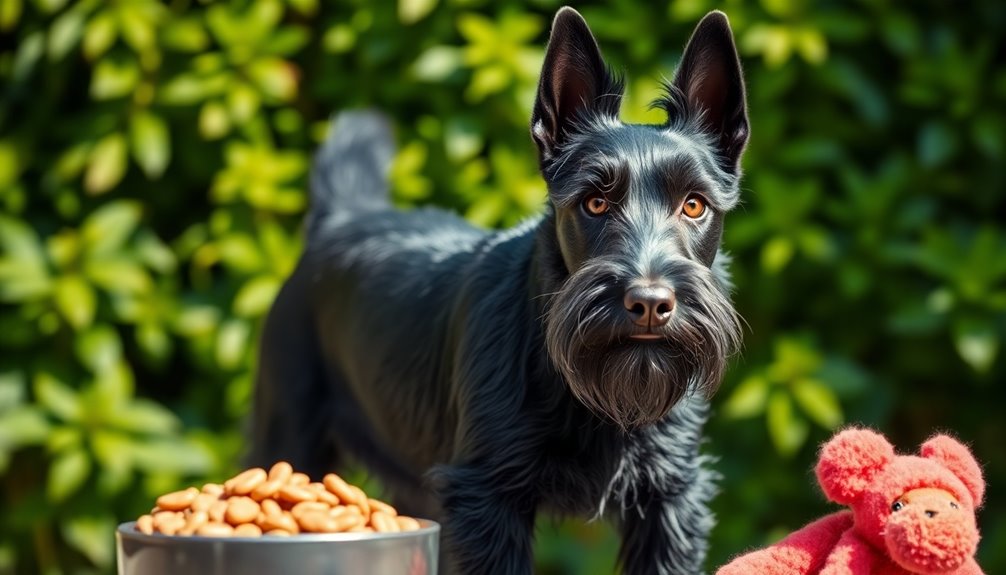
Caring for your Scottish Terrier involves regular brushing to keep their coat healthy and free from mats. You'll also need to meet their exercise requirements, ensuring they get enough physical activity to match their energy levels. Plus, feeding them a balanced diet with high-quality kibble is essential for their overall well-being. Incorporating daily exercise into their routine will help prevent obesity and behavioral issues, contributing to their overall health.
Regular Brushing Required
To keep your Scottish Terrier's coat healthy and free from mats, regular brushing is essential. With their double coat featuring a wiry outer layer and a soft undercoat, daily brushing is recommended to prevent matting and tangling. Regular grooming contributes to overall well-being, ensuring your pet remains comfortable and healthy.
Use a slicker brush to detangle and a greyhound comb to smooth the coat further. When brushing, always go in the direction of hair growth to minimize breakage.
Pay special attention to sensitive areas like the face, ears, and belly. Use soft brushes or your fingers to avoid discomfort. Be aware that matting can occur, especially in the beard, legs, and belly. If you encounter mats, consider using a detangler spray or conditioner to loosen them up.
During shedding season, your Scottish Terrier may shed more, so increase your brushing frequency to manage loose hair effectively. Regular grooming sessions, ideally weekly, help maintain coat health, while professional grooming every 6-8 weeks can address any persistent matting or shedding issues.
Exercise requirements and energy levels
Scottish Terriers have moderate exercise needs that are essential for their physical and mental well-being. You should aim for at least 30-45 minutes of activity each day, which can include brisk walks and playtime in a securely fenced yard.
Morning and evening walks are ideal, with some playtime in between to keep your Scottie engaged.
Scotties love running and chasing toys, although they mightn't always bring them back. Games like fetch and tug-of-war are favorites, and active Frisbee can be a fun way for you both to get some exercise.
Just remember, due to their high prey drive, it's crucial to have a secure area for them to play.
Mental stimulation is equally important. Incorporate puzzle toys and dog sports to challenge their intelligence. You can also use treat dispensers or snuffle mats during mealtime, and hiding treats around the house can provide excellent indoor mental exercise.
Lastly, keep training sessions short and enjoyable, using positive reinforcement. Training classes can further enhance their skills and socialization.
Socializing your Scottish Terrier is vital for developing a well-mannered dog, so expose them to new experiences regularly. This will help manage their medium to high energy levels effectively.
Feeding tips and diet recommendations
Providing your Scottish Terrier with a balanced diet is crucial for maintaining their health and vitality. Focus on high-quality animal-based proteins like chicken, turkey, or fish, which are essential for muscle development. Healthy fats, including omega-3 and omega-6 fatty acids, support their skin and coat health, while complex carbohydrates from whole grains and vegetables provide energy and fiber.
For adult Scotties, serve two meals a day, with portion sizes between 1/2 to 1 cup of premium dog food. Puppies need three to four meals until they're 10 to 12 months old, and seniors may require smaller portions based on their activity levels. Always adjust based on your dog's unique needs and avoid overfeeding to prevent obesity. Regular veterinary check-ups can help ensure dietary adjustments are made as needed for optimal health.
Choose high-quality dog food formulated for small breeds, and consider a raw food diet if you prefer. Look for options with meat as the primary ingredient and avoid fillers or artificial additives.
You might also consider supplements like omega-3 fatty acids for skin health, glucosamine for joint support, and probiotics for digestion. Tailor your Scottie's diet to their specific requirements to ensure they thrive.
Training and Socialization
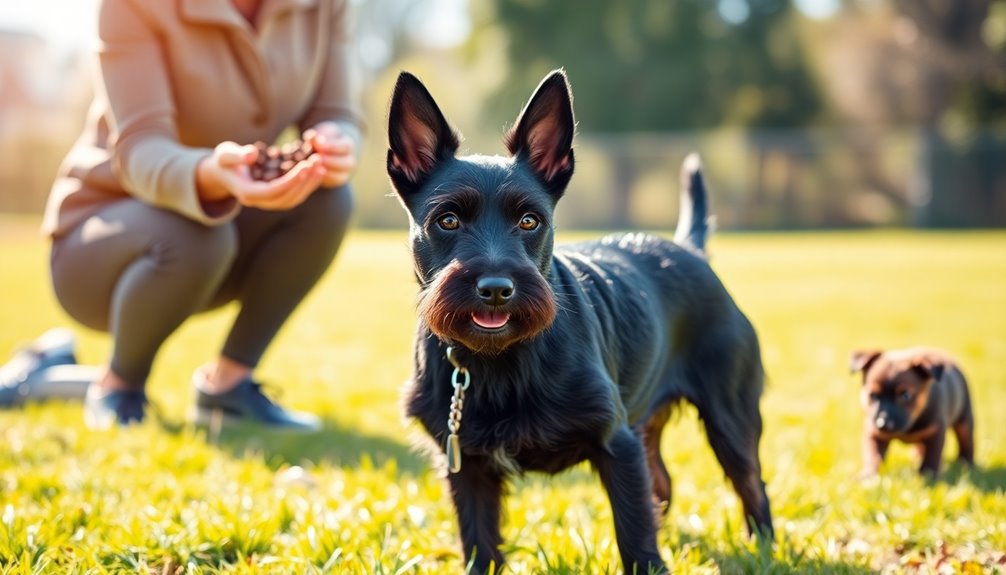
When training your Scottish Terrier, you'll notice their independent learning style, which means patience is key. Training provides mental stimulation that can help keep your dog engaged and focused during sessions. Gradually introducing them to new friends helps build their social confidence and reduces anxiety. Also, be prepared to address leash pulling tendencies during walks, as consistency will make a big difference.
Independent Learning Style
Many Scottish Terriers exhibit an independent learning style that requires a tailored approach to training and socialization. To effectively engage your Scottie, utilize positive reinforcement methods like treats, praise, and affection to reward desired behaviors. Clicker training can also help you mark behaviors precisely, ensuring your dog understands what's being rewarded.
Keep training sessions short—around 5 to 10 minutes—so your dog stays focused and motivated. Being consistent is key; make sure everyone in your household uses the same commands and rules. Embrace a patient approach, as your Scottish Terrier may show stubbornness. Incorporating short, varied sessions will help maintain your dog's interest during training.
Establish clear leadership in your training sessions, and be flexible with your methods, adapting as necessary to find what resonates best with your pup. Early socialization is crucial, so expose your puppy to various environments, sounds, and experiences between 8 and 16 weeks.
Ongoing socialization throughout their life will help maintain confidence. Incorporate high-value rewards and play during training to keep sessions fun and engaging. Above all, always end on a positive note to maintain motivation, ensuring your Scottish Terrier enjoys the learning process.
Gradual Introductions to New Friends
Building on the importance of socialization during your Scottish Terrier's early development, introducing them to new friends should be approached gradually. Start with familiar faces, like family members and close friends, to create a sense of comfort.
As your pup adjusts, expand their circle to include new people, always ensuring these interactions are positive and controlled. Use rewards and praise to reinforce calm and friendly behavior.
When it comes to other animals, proper introductions are crucial. Begin by exposing your Scottish Terrier to well-socialized dogs so they can learn essential social cues. Remember that Scottish Terriers are known for their high spirits and playful demeanor, which can greatly influence their interactions with other pets. Regular grooming can help manage pet hair during these interactions.
Controlled environments, such as a friend's yard or a dog park, can help prevent aggression and fear-based behaviors. It's also important to introduce them to smaller animals, including cats, to ensure compatibility with existing pets in your household.
Don't forget to vary the environments your pup experiences. Take them to parks, cities, or beaches, and expose them to different sights and sounds. This will enhance their confidence and adaptability, making them more comfortable in unfamiliar settings. By gradually and positively introducing your Scottish Terrier to new friends, you'll help them grow into a well-adjusted companion.
Leash Pulling Tendencies
Leash pulling can be a frustrating challenge for Scottish Terrier owners, often rooted in their strong prey drive and independent nature. This breed's excitement and curiosity can lead to pulling, especially when they catch a whiff of potential prey or interesting smells.
To tackle this, start by establishing clear rules and structure in your training sessions. Lack of consistency can worsen leash pulling and other behavioral issues. Establishing rules and structure is essential in helping dogs identify as followers, not leaders. Regular outings to puppy training classes can also enhance their socialization and improve leash manners.
Using a Martingale collar can help curb pulling more effectively than a standard harness. Keep your training sessions short and engaging to maintain your pup's attention. Reward good leash behavior with treats and praise to reinforce calm walking.
Whenever your Scottish Terrier pulls, simply stop walking and wait for a loose leash before proceeding. Incorporate life rewards, like letting them sniff around, to make walking nicely more appealing.
Socialization is also key; expose your pup to various environments to prevent behavioral issues. Practice heeling regularly, beginning with your left foot to help your dog keep pace.
Ideal Living Environment
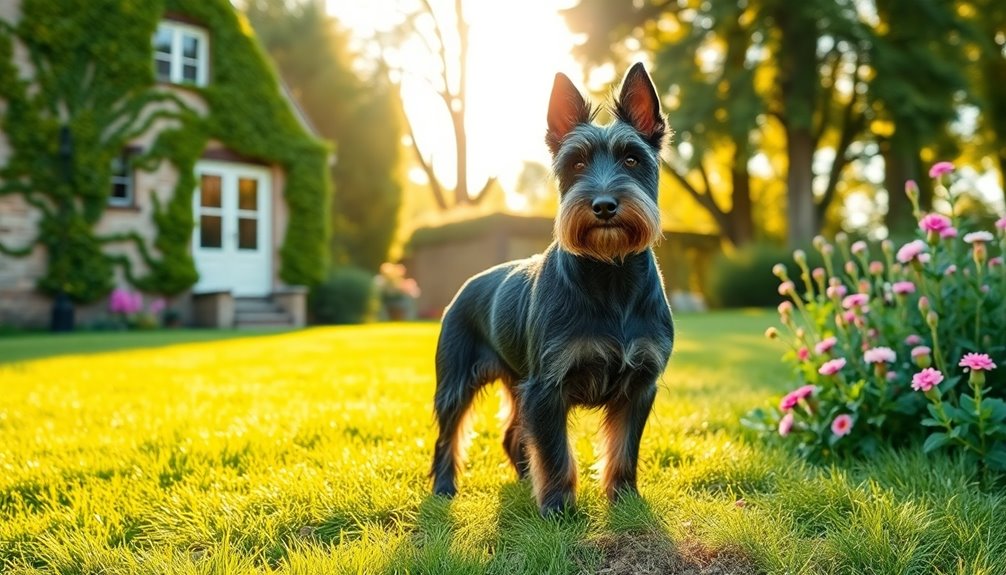
If you're considering a Scottish Terrier, you'll want a small home with outdoor access, as they thrive in such environments.
They prefer cooler, temperate climates, which suit their double coat well. Providing a space where they can explore outdoors is essential for their happiness and health. Additionally, daily exercise is crucial for their overall well-being, so having an area for them to run and play is highly beneficial.
Small Home With Outdoor Access
In today's fast-paced world, a small home with outdoor access can be the perfect living environment for a Scottish Terrier. These dogs adapt well to apartments and homes with gardens, making them versatile companions. However, regardless of your living space, they require regular exercise to stay fit and happy. Daily walks and play sessions are essential to meet their energy needs. Additionally, incorporating a quick breakfast option can help you start your day on the right foot before heading out for those walks.
Outdoor access is crucial for your Scottish Terrier's physical activity and mental stimulation. A fenced yard is necessary to keep them safe, given their strong chase instinct. While they enjoy exploring, it's important not to leave them alone in the garden to prevent digging. Additionally, regular dental care is vital for maintaining their overall health, as Scottish Terriers are particularly prone to dental disease.
For walks, seek out remote areas to minimize distractions and enhance their experience. Aim for at least two 30-minute walks each day, supplemented by playtime and engagement in activities like agility or Earthdog. This routine not only keeps them active but also strengthens your bond. With proper care and supervision, a small home with outdoor access offers the ideal environment for your spirited Scottish Terrier, allowing them to thrive in both urban and rural settings.
Prefers Cooler, Temperate Climates
Scottish Terriers thrive best in cooler, temperate climates, making these environments ideal for their health and happiness. Their dense double coat provides insulation, allowing them to handle cold weather fairly well. You'll notice your Scottie enjoying brisk walks in cooler temperatures, but keep an eye out during extreme cold. Ensure they've access to warm indoor spaces when the weather gets harsh.
However, these little terriers aren't as fond of hot weather. Their thick coat makes them prone to overheating, so it's crucial to provide shade and fresh water during warmer months. Avoid intense exercise during the hottest parts of the day, as this can lead to heat-related issues. Additionally, it's important to be aware that Scotties have a higher incidence of bladder cancer, which can be exacerbated by heat stress.
Scotties prefer moderate temperatures and do best in climates with mild winters and summers. They can struggle with extreme temperature fluctuations, so be mindful of their comfort.
Adjust their exercise routine accordingly, ensuring they get regular, moderate activity regardless of the weather. Lastly, always monitor your pup for signs of discomfort, and provide shelter from the elements to keep them happy and healthy.
With the right climate conditions, your Scottish Terrier will thrive!
Scottish Terrier's Distinctive Gait
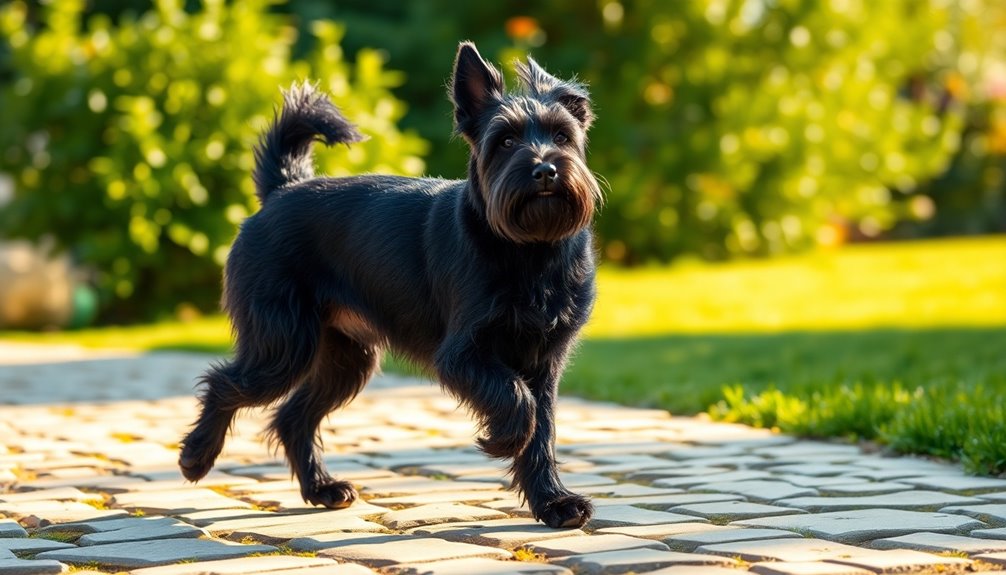
When you watch a Scottish Terrier move, you'll notice their unique gait that sets them apart from other breeds. Their forelegs don't move in perfect parallel, creating a charming "Scottie roll" as they trot. This distinctive movement, influenced by their compact build and strong rear drive, reflects their agile and coordinated nature. This gait is a result of their short legs, which contribute to their sturdy and compact appearance.
Distinctive Beard Grooming Rituals
Grooming your Scottish Terrier's distinctive beard is an essential ritual that not only enhances their iconic appearance but also promotes their overall health. You'll want to clean the beard regularly, especially after meals or outdoor activities, to keep dirt, saliva, and food particles at bay.
Using vet-approved dog wipes makes for quick cleanups, while a slicker brush or greyhound comb helps detangle the fur. If you encounter mats, apply a detangler spray before gently working them out to prevent discomfort.
When trimming, follow the natural contours of your dog's face. Use sharp, curved scissors and clippers, and reference anatomical landmarks like the mole under the chin to shape the beard and eyebrows accurately. Regular grooming reduces the risk of skin irritations and infections, promoting your dog's overall health and well-being.
Daily brushing is crucial to prevent matting, and a weekly grooming session should include a thorough clean, trimming, and ear checks.
Regular grooming also allows you to inspect your dog's skin for any issues and keep their coat healthy. Don't forget about dental hygiene; brushing their teeth is just as important.
Establish a consistent grooming schedule, and consider professional grooming every 6-8 weeks to maintain that distinctive Scottish Terrier look.
Famous Scottish Terrier: Fala
One iconic figure in the world of Scottish Terriers is Fala, the beloved pet of President Franklin D. Roosevelt. Gifted to Roosevelt in 1940 by his cousin Margaret Suckley, Fala quickly became a symbol of loyalty and companionship, often by the President's side during trips and at the White House. His presence significantly boosted the popularity of Scottish Terriers across the nation.
Fala's distinctive gait, characteristic of the breed, caught many eyes. With a deep, broad chest and short legs, his forelegs didn't move in perfect parallel but instead inclined slightly inward. This unique movement created what's known as the "Scottie roll." Scotties should appear compact and powerfully built, showcasing the breed's renowned physical traits.
You could see Fala's agility and coordination as he moved with powerful drive from the rear, where his legs executed a square and true action.
Fala wasn't just a pet; he was a cultural icon. He appeared in various photographs and films, and even sparked interest in political memorabilia. His legacy lives on, not just in history but also as a cherished reminder of the bond between a president and his dog.
Fala remains one of the most famous Scottish Terriers in history.
Independent and Strong-Willed?

When you consider bringing a Scottish Terrier into your home, be prepared for their independent and strong-willed nature. This breed thrives under the guidance of experienced handlers who understand their grooming needs and frequency. With patience and the right approach, you can truly enjoy the unique character of these confident companions. Additionally, their grooming requires safe and trusted content that can be found in various resources to help you care for them effectively.
Ideal for Experienced Handlers
For those considering a Scottish Terrier, it's essential to recognize that this breed is best suited for experienced handlers. Their independent and stubborn nature means they won't respond well to traditional training methods. Instead, you'll need to approach training with patience and creativity, as they prefer to think their actions are their own ideas.
This breed thrives on positive reinforcement, so you'll want to use praise and rewards effectively. Expect training sessions to be short and engaging, ideally lasting only 5-10 minutes. Long, repetitive exercises can lead to boredom, making them less responsive. Quitting on a positive note is crucial to prevent sour impressions. Additionally, it's important to note that their average lifespan is typically between 12 to 15 years, which emphasizes the importance of proper care throughout their life.
Consistency among family members in commands and rules is vital, as mixed signals can confuse your Scottish Terrier. Keep in mind that their strong-willed temperament may lead to aggressive behavior towards other dogs, so early socialization is key.
With proper handling, mental stimulation, and a fun approach to training, you'll unlock the potential of your Scottish Terrier. If you're ready to embrace their independent spirit, this breed can be a rewarding companion.
Grooming Needs and Frequency
Regular grooming is crucial for keeping your Scottish Terrier's coat healthy and free from mats. Daily brushing is essential to prevent tangling and matting. Use a slicker brush or greyhound comb to remove loose hair and distribute natural oils, which helps maintain skin and coat health. Soft brushes like the Artero Stella are great for these daily sessions, and they also strengthen the bond between you and your dog.
Once a week, set aside time for a thorough grooming session. This should include bathing if needed, trimming and shaping the coat, cleaning the ears, and brushing the teeth. Pay special attention to dirt-prone areas like the beard and legs, and consider using a detangler spray to ease out any mats. Incorporating a de-shedder into your routine can also assist in removing the undercoat and promoting coat renewal.
At least once a month, give your dog a bath to maintain hygiene. During heavy shedding seasons, increase your grooming frequency. Monthly nail trimming is also necessary to prevent discomfort.
Finally, consider professional grooming every 6-8 weeks to keep your dog's coat looking its best and to avoid grooming-related issues.
Frequently Asked Questions
How Much Exercise Does a Scottish Terrier Need Daily?
A Scottish Terrier needs about 30-45 minutes of exercise daily. You can break this up into morning and evening walks, plus some playtime in between.
It's important to mix physical activities with mental stimulation to keep them engaged. Remember, puppies require shorter play sessions throughout the day.
Avoid excessive exercise to protect their growing bones and joints, and keep their activities varied to prevent boredom. Regular breaks are essential too!
Are Scottish Terriers Good With Children and Other Pets?
Scottish Terriers aren't typically great with young children or small pets.
They can be intolerant of noise and may react negatively to boisterous antics. If you've got older kids who understand boundaries, they might bond well.
However, with small pets, their high prey drive can lead to trouble, so it's best to keep them separate.
Early socialization is crucial for managing their interactions with other dogs and ensuring a harmonious environment.
What Is the Average Cost of a Scottish Terrier Puppy?
The average cost of a Scottish Terrier puppy typically ranges from $800 to $2,500, depending on various factors.
Breeder reputation and puppy lineage can significantly affect the price. You might find top-quality puppies priced up to $3,500, especially from reputable breeders.
If you're considering adoption, you could pay as little as $300.
Remember to factor in additional costs like veterinary care, grooming, and food when budgeting for your new companion.
How Often Should I Groom My Scottish Terrier?
You should groom your Scottish Terrier regularly to keep its coat healthy and looking great. Aim for daily brushing to remove loose hair and prevent matting, especially in areas like the beard and legs.
Monthly grooming is essential, too; trim nails, clean ears, and bathe as needed. Don't forget to schedule professional grooming every 6-8 weeks for a thorough trim and to maintain that distinctive look.
Consistency really makes a difference!
Do Scottish Terriers Have Any Specific Dietary Requirements?
Yes, Scottish Terriers have specific dietary requirements. You should focus on high-quality animal-based proteins like chicken or beef, ensuring a mid-20% protein content.
Incorporate healthy fats, including omega-3 and omega-6 fatty acids, to support their skin and coat.
Add complex carbohydrates from whole grains and vegetables for energy and fiber.
Don't forget essential vitamins and minerals, plus keep them well-hydrated to maintain overall health.
Conclusion
In conclusion, the Scottish Terrier is a bold and independent breed that captures hearts with its unique personality and striking appearance. With proper training and socialization, you'll find that their strong-willed nature can be a rewarding challenge. Whether you live in a cozy apartment or a spacious home, this spirited terrier thrives with love and attention. Embrace the quirks and charm of your Scottish Terrier, and you'll enjoy a loyal companion for years to come.

